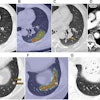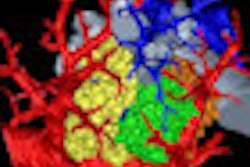Monday, November 26 | 10:30 a.m.-10: 40 a.m. | SSC01-01 | Room S405AB
Prospective dual-source coronary CT (DSCT) angiography can reduce radiation dose and produce high-quality images even in patients with atrial fibrillation (AF), according to researchers from China.A recent study showed that prospective electrocardiogram (ECG)-triggered sequential DSCT is feasible in patients with atrial fibrillation. The technique can decrease radiation exposure by approximately 50% compared to retrospectively ECG-gated spiral DSCT while preserving image quality, explained Dr. Lu Lin from Peking Union Medical College Hospital in Beijing.
"We tried to explore the feasibility of a prospectively ECG-triggered sequential scan protocol in patients with AF compared to retrospectively ECG-gated spiral DSCT," Lin told AuntMinnie.com.
The group scanned 32 patients with suspected coronary artery disease on a second-generation 128-slice dual-source CT scanner. Half underwent prospectively ECG-triggered sequential scans, while the other half had spiral CT scans. The mean heart rate was 97 beats per minute, with a range of 65 to 73 beats per minute. The radiation dose was significantly reduced in the sequential scan group (4.88 mSv) compared to the spiral group (10.2 mSv).
"Using the prospectively ECG-triggered sequential scan protocol in DSCT coronary angiography, we effectively reduced the radiation dose in patients with AF without sacrifice in image quality," according to Lin.




















